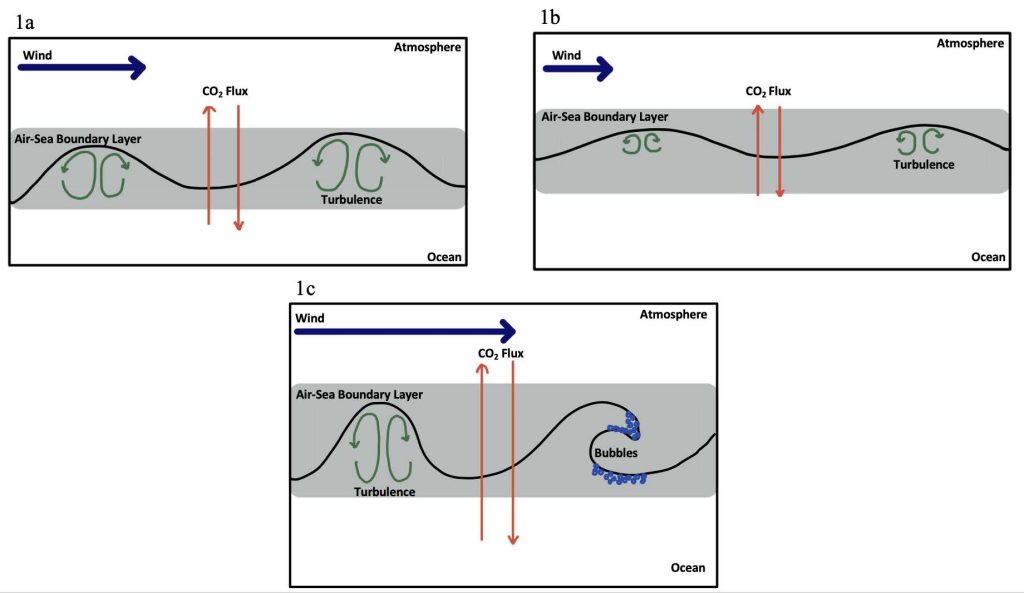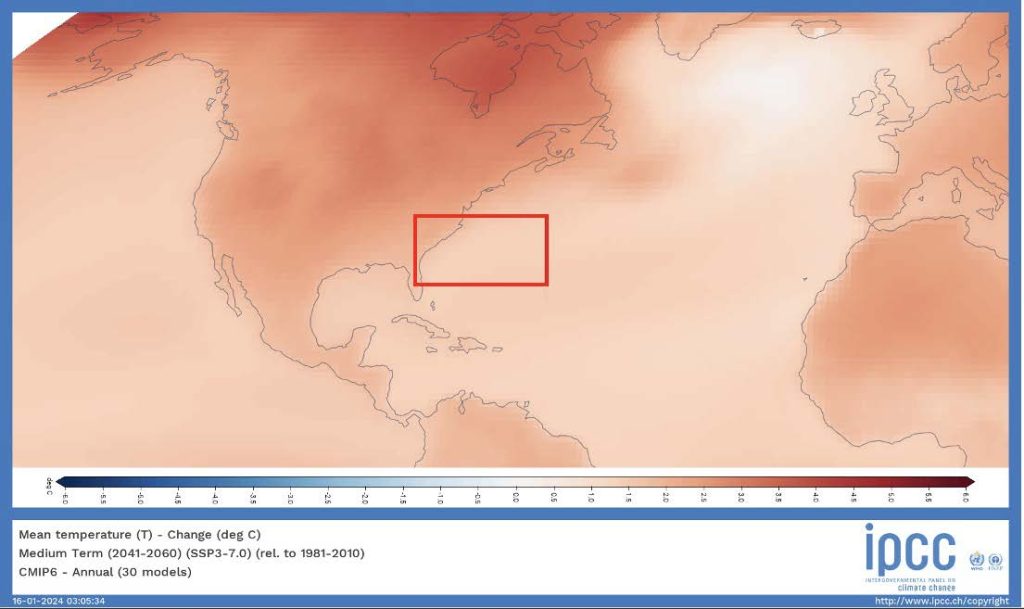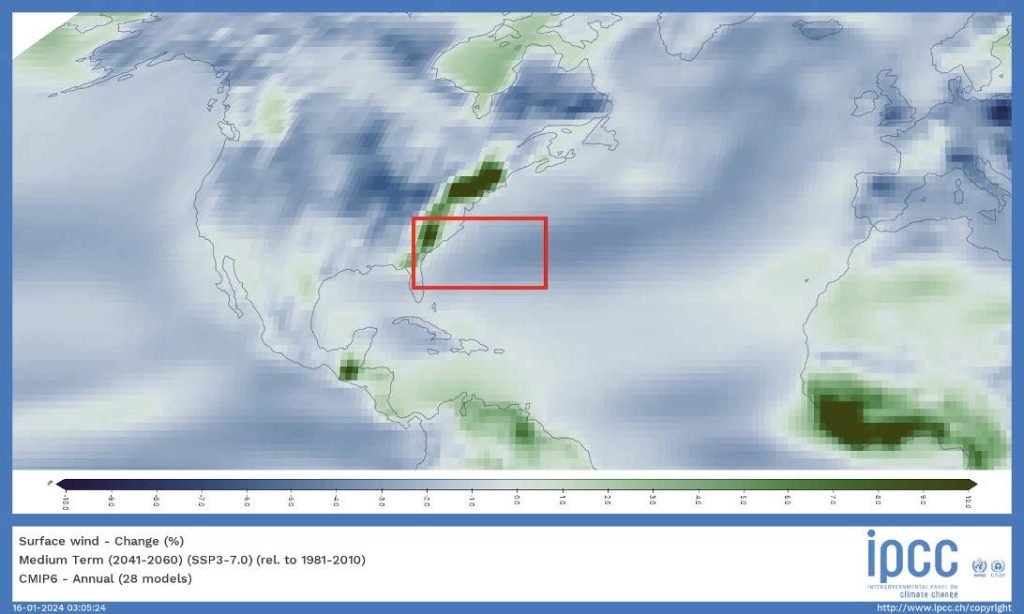The future of CO2 flux in the South Atlantic Bight: the effects of temperature and wind
by Courtney Bass, Marine Sciences
The ocean is one of the world’s greatest sinks of atmospheric carbon dioxide (CO2). The interaction between the ocean and atmosphere in the air-sea boundary layer allows for the flux of CO2. The magnitude of the air-sea CO2 flux is dependent on the partial pressure of CO2 at the ocean surface and the gas exchange velocity. The environmental forces behind these two components are sea surface temperature and wind speed, respectively. Climate models generated by the Intergovernmental Panel on Climate Change predict significant changes in both wind speed and temperature because of climate change. These potential changes will impact the magnitude of CO2 taken up by the ocean. In this paper, climate models are used to predict the change in air-sea CO2 flux in the South Atlantic Bight (SAB) region along the Southeastern US coast because of global warming. The results show that the SAB will undergo a transformation from being a sink of atmospheric CO2 to a source of atmospheric CO2, thereby contributing to the primary cause of global warming and creating a positive feedback loop.
South Atlantic Bight, CO2 flux, wind speed, sea surface temperature, climate models
Introduction
The industrial revolution brought about significant changes in the way humans live and altered the global carbon cycle that controls many aspects of our Earth. The release of carbon dioxide (CO2) into the atmosphere has increased dramatically since the burning of fossil fuels became the standard way to generate energy. CO2 is the most abundant greenhouse gas (GHG) released from anthropogenic activities1. GHGs trap outgoing longwave radiation in the atmosphere resulting in a warming effect on Earth1. The ocean and terrestrial carbon sinks have been put under increased amounts of stress to balance the influx of carbon in the atmosphere1. The ocean and terrestrial environments act as carbon sinks by taking up CO2 from the atmosphere and storing the carbon within their respective systems1. The ocean is one of the world’s greatest carbon sinks, taking up 26% of CO2 that is released through anthropogenic activities2,3. Its ability to take up CO2 from the atmosphere is a function of the gas exchange velocity, or the speed at which gases pass through the air-sea border, and the partial pressure of CO2. Temperature and wind are the main environmental forcing agents that dictate the magnitude of the air-sea CO2 flux. As increasing amounts of CO2 are released into the atmosphere, temperatures on land and in the ocean rise and wind speed becomes more variable across the globe. These changes to sea surface temperature (SST) and surface wind speed will alter the amount of CO2 taken up by the ocean. The ability to accurately predict changes in CO2 flux is crucial when projecting future atmospheric CO2 and determining how much the carbon cycle will change on a regional and global scale.
The change in magnitude of atmospheric CO2 taken up by the ocean varies by region. In coastal regions such as the South Atlantic Bight (SAB) in the Southeastern U.S. Coast, the amount of carbon taken up by the ocean fluctuates due to seasonal variations in wind speed and temperature2. There have been opposing findings concerning whether the SAB currently acts as a net sink or source of atmospheric CO2. The most recent consensus is that the SAB is a small net sink of atmospheric CO2 4,5. However, the debate on the role of the SAB in the global carbon cycle might be reignited due to the predicted increase in variability of wind speed and temperature as this region’s climate changes. Based on the most recent climate models, the predicted changes in wind speed and sea surface temperature in the SAB will diminish its ability to take up atmospheric CO2 and will result in it becoming a net source of atmospheric CO2.
CO2 Flux in the South Atlantic Bight
Traditional variability in the air-sea CO2 fluxes in the SAB have been observed on both a spatial and temporal scale. The main driver behind these variations is sea surface temperature3. Jiang et al. concluded that, while the SAB is a net sink of atmospheric CO2 on an annual scale, it functions as a source of CO2 in the summer and a sink in the winter5. On the spatial scale, the inner continental shelf is a net source while the middle and outer continental shelves are net sinks5. Furthermore, the northern SAB acts as a net sink of atmospheric CO2 while the southern SAB acts as a net source5. The historic variability in air-sea CO2 flux in the SAB is important because it can be used as a baseline to analyze how predicted changes in wind speed and temperature will affect the CO2 flux in the SAB, and thus the role of the SAB in the global carbon cycle.
Mechanisms of CO2 Flux
The gas exchange velocity and the partial pressure gradient between the surface of the ocean and the atmosphere directly above it are used to calculate air-sea fluxes of CO2 6,7. The relationship between gas exchange velocity and sea surface partial pressure of CO2 (pCO2) is derived from the assumption that wind causes shear and turbulence in the boundary layer between the atmosphere and the ocean, thus affecting the magnitude of gas that is able to move through that layer7 (Fig. 1a). Sea surface temperature is the main factor creating variance in the pCO2 since partial pressure increases as temperature increases. Therefore, if sea surface temperature increases and the gas exchange velocity is held constant, the magnitude of the air-sea CO2 flux would increase. However, when sea surface temperature is uniform there is still significant variation in CO2 flux across the shelf of the SAB. This persistence of variation shows the importance of other factors controlling CO2 flux, like wind speed.
Wind speed influences air-sea CO2 flux through its relationship with gas exchange velocity8. Under slower wind conditions (~ < 3 m s-1), other controlling factors, like temperature, have a stronger impact on the gas transfer velocity7 (Fig 1b). Under faster wind conditions (~ > 15 m s-1), wind speed becomes the dominant force controlling gas transfer velocity7. Faster wind results in an increased abundance of bubbles formed during wave breaks and these bubbles enhance the gas exchange velocity (Fig. 1c)7. This influence of wind speeds on CO2 flux is seen in both the spatial and temporal variations of air-sea CO2 fluxes in the SAB. Seasonally, wind speeds are higher in the winter, correlating to a time where the SAB acts as a net sink for atmospheric CO2 5. Wind speeds are slower in the summer when the SAB acts as a source for atmospheric CO2 5. Additionally, wind speeds are highest in the north SAB and lower in the south SAB5. Thus, wind speeds are an important factor in determining the gas exchange rate and therefore the amount of CO2 being transported between the ocean and the atmosphere.

Figure 1: Illustrations of the effect of wind speed on CO2 flux under 1a) average wind speeds, 1b) slow wind speeds, 1c) fast wind speeds. Length of arrows represents magnitude. (Credit: Author)
Climate Model Analysis
According to the Intergovernmental Panel on Climate Change (IPCC), shifts in wind patterns due to climate change have already been observed and are expected to continue, along with changes in sea surface and land temperature9. By modeling future climate conditions using different GHG emission scenarios, the IPCC has been able to produce maps predicting changes in climate across each region of the globe. The models for predicted changes in wind speed and temperature were generated based on a 1981-2010 baseline using CMIP6 (Fig. 2, Fig. 3). CMIP6 is the most recent product of the Coupled Model Intercomparison Project which is a collaborative effort to produce a well-rounded and cohesive global climate model10. The model used in this paper is based on the SSP3-7.0 emissions scenario. This scenario projects what conditions will look like if nothing is done to decrease or mitigate GHG emissions in the near future11.
According to the predicted changes in mean temperature, the sea surface temperature in the SAB will rise by ~1-2 degrees Celsius (Fig. 2). While this is a noteworthy increase in sea surface temperature, the model does not predict any spatial variability in this change. The temperature increase is likely to be consistent throughout the whole SAB. If temperature is considered as the only environmental forcing agent of the gas exchange velocity, the lack of spatial variability in its predicted change means the magnitude of air-sea CO2 flux in the SAB would increase. The effect of climate change on the air-sea CO2 flux in the SAB becomes much more complicated when considering other forcing agents like wind speed.
The predicted changes in wind speed map shows the SAB is likely to experience decreased wind speeds on the order of 2-4% lower than wind speeds recorded during the baseline period (Fig. 3). Additionally, this decrease in wind speed is not projected to be uniform along the continental shelf portion of SAB. Therefore, it will not have one consistent effect on the entire SAB region like the predicted changes in temperature. The outer shelf is expected to see a stronger decrease in wind speed than the inner shelf. If temperature is held constant, this prediction means that the region of the SAB that contributes most to its ability to act as a CO2 sink will experience the greatest decrease in wind speed. The prediction also suggests that the region of the SAB that is responsible for the release of CO2 into the atmosphere will see the smallest decrease in wind speed. Therefore, the gas exchange velocity would decrease in the inner shelf making it a stronger source of atmospheric CO2, and it would increase in the outer and middle shelves making them weaker sinks for atmospheric CO2. Since the SAB is already a very small sink of atmospheric CO2, it is likely that the enhancement of the CO2 gas exchange due to decreased wind speed in the inner shelf would convert the SAB into a net source of CO2.

Figure 2: Predicted changes in mean temperature on a medium-term time scale (2041-2060) based on the SSP3-7.0 scenario using a 1981-2010 baseline. Red box indicates the approximate location of the South Atlantic Bight (Credit: IPCC) 11.

Figure 3: Predicted wind speed changes on a medium-term timescale (2041-2060) based on the SSP3-7.0 scenario using a 1981-2010 baseline. Red box indicates the approximate location of the South Atlantic Bight (Credit: IPCC) 11.
Conclusion
The implications of these results are concerning, but not absolute. Adding another source of CO2 to the atmosphere would have a significant effect on the global carbon cycle. This would contribute to a positive feedback loop where the effects of global warming enhance the causes of global warming. However, there are other factors that might change this prediction. Future research could focus on the role that Gray’s Reef, a coral reef located in the middle shelf of the SAB, has in the regional carbon cycle of the SAB. Since coral reefs can act as sources or sinks of atmospheric CO2, understanding how regional coral reefs behave could aid in determining if and to what magnitude future wind speed changes will affect air-sea CO2 flux12.
While these models are interesting to theorize about, they are not indisputable. This analysis has included models of both wind speed and temperature, but other models might include additional environmental forcing agents which could produce different results. It is important to note that other studies that considered only SST warming also determined the SAB would switch from being a small sink to a source of atmospheric CO2 3. This aligns with the model predictions discussed above. If CO2 emissions continue to increase according to the SSP3-7.0 scenario, regions of the ocean that have historically been relieving the atmosphere of CO2 will become a contributor of atmospheric CO2. The analysis of these models support the idea that a positive feedback loop is being created and that global warming will have a significant effect on the magnitude of air-sea CO2 flux and thus on the role of the ocean as a major carbon sink.
References
- Lindsey, R., Climate Change: Atmospheric Carbon Dioxide. https://www.climate.gov/news-features/understanding-climate/climate-change-atmospheric-carbon-dioxide#:~:text=Carbon%20dioxide%20is%20Earth%27s%20most,including%20back%20toward%20Earth%27s%20surface. (2023)
- Cahill, B., Wilkin, J., Fennel, K., Vandemark, D., & Friedrichs, M. A. M., Interannual and seasonal variabilities in air-sea CO2 fluxes along the U.S. eastern continental shelf and their sensitivity to increasing air temperatures and variable winds. J. of Geophys. Res. Biogeosci., 121, 295-311 (2016).
- Dong, Y., et al., Update on the temperature corrections of global air-sea CO2 flux estimates. Global Biogeochem Cycles, 36 (2022).
- Cai, W.-J., Dai, M., & Wang, Y., Air-sea exchange of carbon dioxide in ocean margins: A province-based synthesis. Geophys. Res. Lett, 33 (2006).
- Jiang, L., Cai, W., Wanninkhof, R., Wang, Y., & Lüger, H., Air-sea CO2 fluxes on the U.S. South Atlantic Bight: Spatial and seasonal variability. J. of Geophys. Res., 113 (2008).
- Gu, Y., Katul, G. G., & Cassar, N., The intensifying role of high wind speeds on air-sea carbon dioxide exchange. Geophys. Res. Lett, 48 (2021).
- Wanninkhof, R., Relationship between wind speed and gas exchange over the ocean revisited. Limnol. Oceanogr,: Methods, 12, 351-362 (2014).
- Weber, A. H., & Blanton, J.O., Monthly mean wind fields for the South Atlantic Bight. J. of Phys. Oceanogr., 10, 1256-1263 (1980).
- Eichelberger, S., McCaa, J., Nijssen, B., & Wood, A., Climate change effects on wind speed. N. Amer. Windpower, 7, 68-72 (2008).
- Hausfather, Z., CMIP6: the next generation of climate models explained. https://www.carbonbrief.org/cmip6-the-next-generation-of-climate-models-explained/ (2019)
- Gutiérrez, J.M., et al. 2021: Atlas. In Climate Change 2021: The Physical Science Basis. Contribution of Working Group I to the Sixth Assessment Report of the Intergovernmental Panel on Climate Change. http://interactive-atlas.ipcc.ch/ (2021)
- Bates, N. R., Seasonal variability of the effect of coral reefs on seawater CO2 and air-sea CO2 exchange. Limnol. Oceanogr., 47, 43-52 (2002).
Acknowledgements: I would like to thank Dr. Catherine Edwards and Laura McKee for their guidance and support in writing this paper. I would also like to thank my mother, Dena Bass for her unwavering support.
Citation Style: Nature
